There are hundreds of different conifer species in several families, so it can be hard to know which is which. Learn how to properly identify conifer trees, including pine, fir, spruce, hemlock, juniper, cedars, and more!
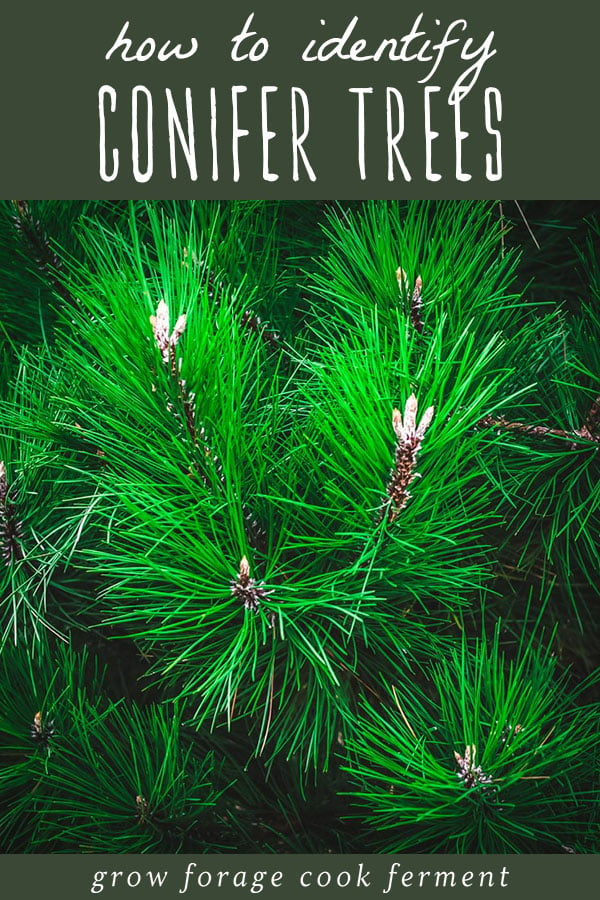
Want to save this post for later?
Wildcrafting Weeds
If you want to learn more about the edible and medicinal weeds that surround us and how to use them, check out my eBook: Wildcrafting Weeds: 20 Easy to Forage Edible and Medicinal Plants (that might be growing in your backyard)!
What are Conifer Trees?
Conifers are evergreen trees with needles or scales as their leaves. There are many species of conifers within several families. Conifer trees grow worldwide in temperate regions.
Most conifers are more or less edible and usable, with one big exception of the Yew family, which is highly toxic. There are a few other species that are questionably toxic or otherwise not edible, but not to the same degree as Yew.
Because of this, it’s very important to properly identify and research the conifers that grow in your region before using.
Please see my post on the best foraging books to help you get started on identification resources. I also have a post on foraging for conifer needles for further reading.
I’m going to go over the most commonly found conifer families and species that are used for edible and medicinal purposes, and how to identify them. I will also talk about the toxic conifer species and how to identify each.
Get more of my favorite food, drink, medicine, and body care recipes that use pine, fir, spruce, and other conifer needles in my ebook Foraged Conifer Recipes for Body, Mind, and Health!
Pinaceae Family
The Pinaceae family is very large and contains some of the most commonly foraged conifers, such as pine, fir, Douglas-fir, spruce, hemlock, and true cedars.
Pine Tree Identification
Pine trees (Pinus spp.) have needles that are bundled in clusters of 1-7, with 2-5 being most common, depending on the species. The needles are often longer than those of other conifers, but not always.
The needles and branches grow in a spiral pattern. New spring growth at the tips of branches are brown or whitish and scaly, sometimes called “candles.”
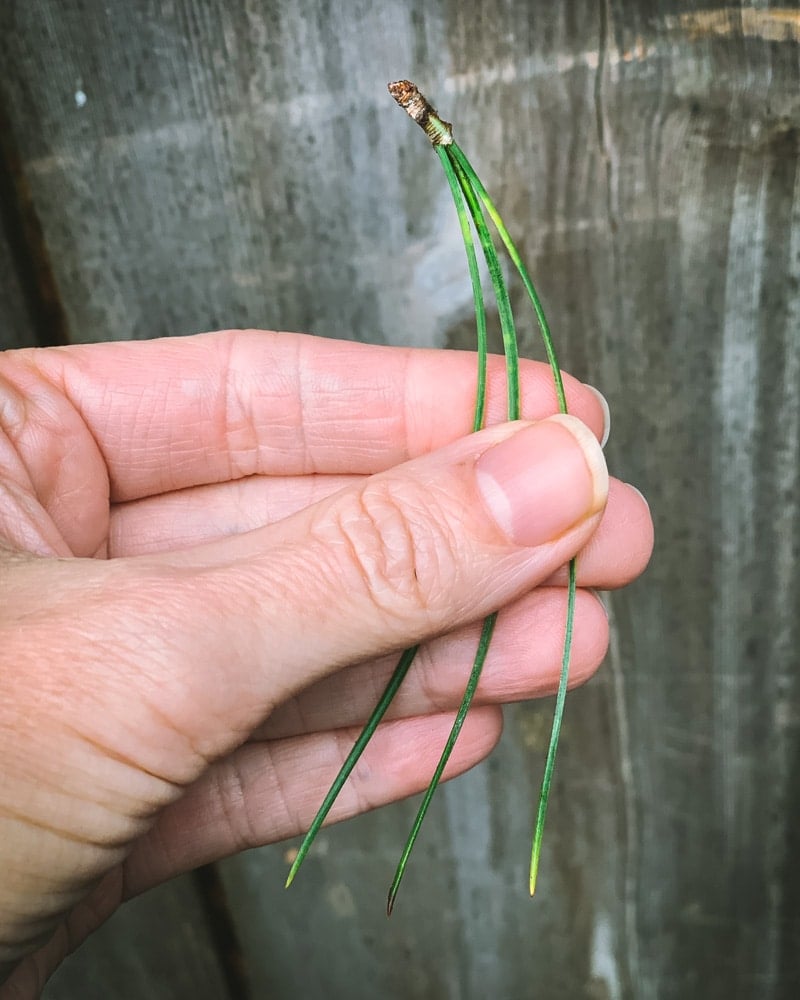
The bark of most pine trees is thick and scaly, but in some species it is thin and flaky. Ponderosa pine (Pinus ponderosa) has scaly bark that resembles puzzle pieces.
Pine cones are woody and brown with spirally arranged scales, hanging downward. The seeds are small and winged.
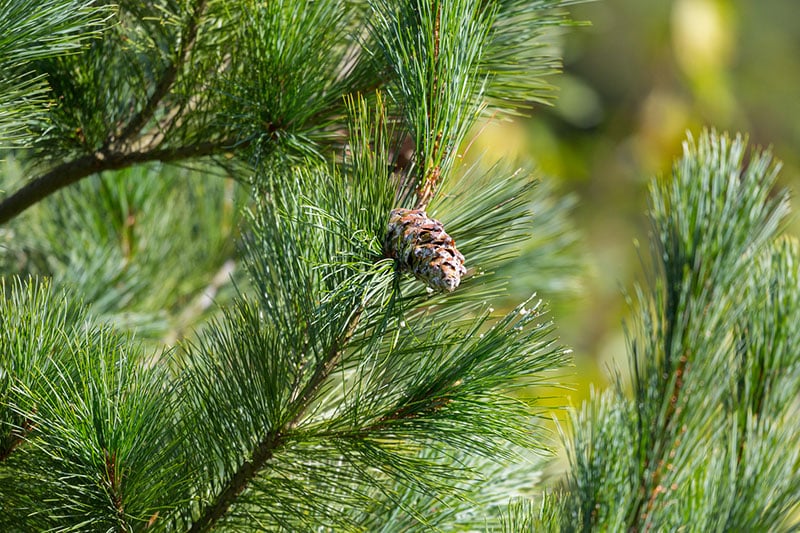
Many species of pine trees produce edible pine nuts, most notably the Piñon pine (Pinus edulis).
Some other common pine species in the United States and Canada are:
- Western white pine (Pinus monticola)
- Eastern white pine (Pinus strobus)
- Virginia pine (Pinus virginiana)
- Loblolly pine (Pinus taeda)
- Sugar pine (Pinus lambertiana)
- Lodgepole pine (Pinus contorta)
Those are just a select few, as this is a huge genus!
One thing to note is that Ponderosa pine (Pinus ponderosa), and potentially other yellow pines, should not be used internally by pregnant women, as there is a small chance that they could cause miscarriage.
Fir Tree Identification
Fir trees (Abies spp.) have needles that attach to the branch by a base that looks like a tiny suction cup.
The needles are soft and flattened, and usually have two white lines on the underside. Fir needles tend to point upwards, but this is not always the case.
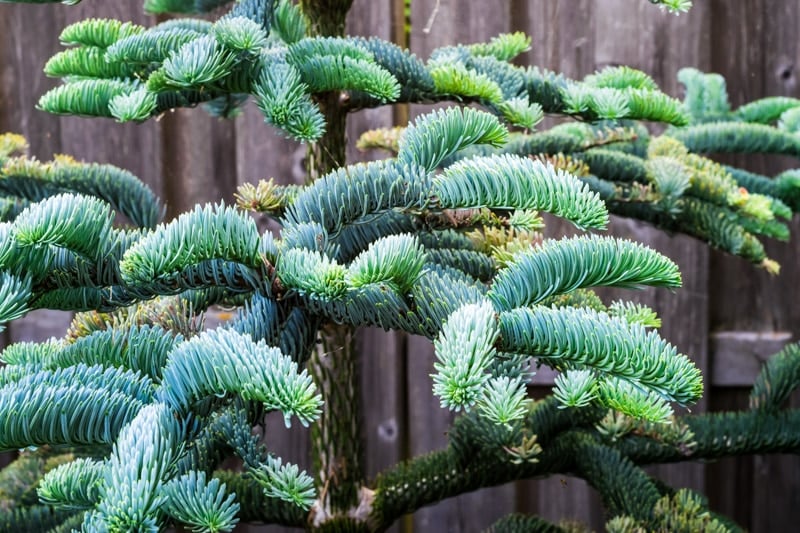
One distinguishing feature of fir trees is that the cones do not hang downward, but stand up straight like candlesticks. Mature cones can be brown, blue, purple, or black in color, depending on the species.
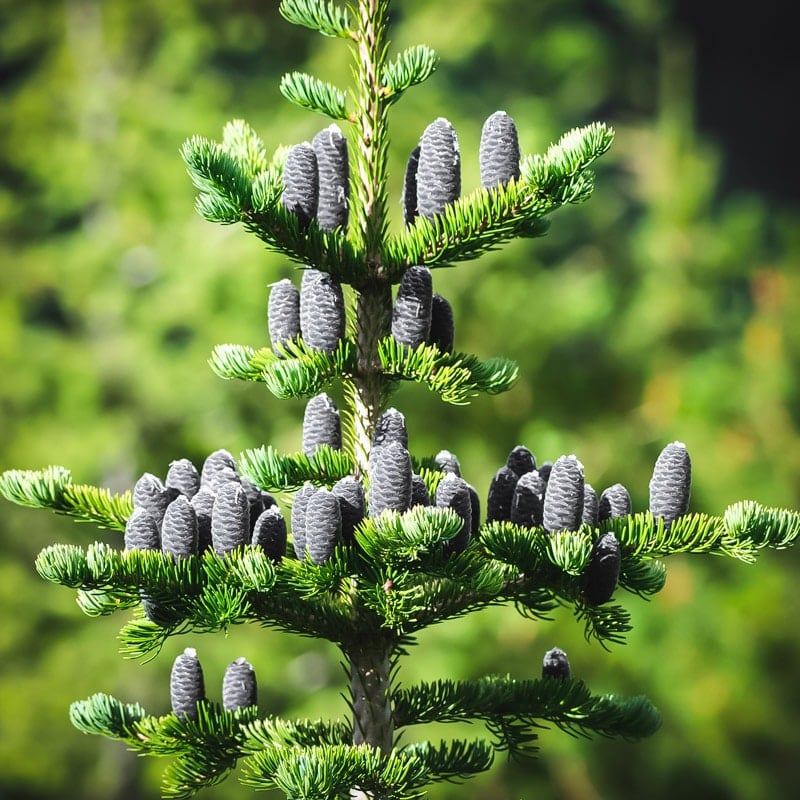
Fir trees are popular as Christmas trees.
Some common species of fir trees in the United States and Canada include:
- White fir (Abies concolor)
- Grand fir (Abies grandis)
- Noble fir (Abies procera)
- Rocky Mountain fir (Abies lasiocarpa)
- Basalm fir (Abies balsamea)
Douglas-fir Tree Identification
Douglas-fir (Pseudotsuga spp.) is not a true fir tree. Its Latin name means “false hemlock,” so it’s not a hemlock tree either, but its own genus all together.
Douglas-fir trees, particularly Pseudotsuga menziesii, are very common in western North America. There are also a few species in Asia.
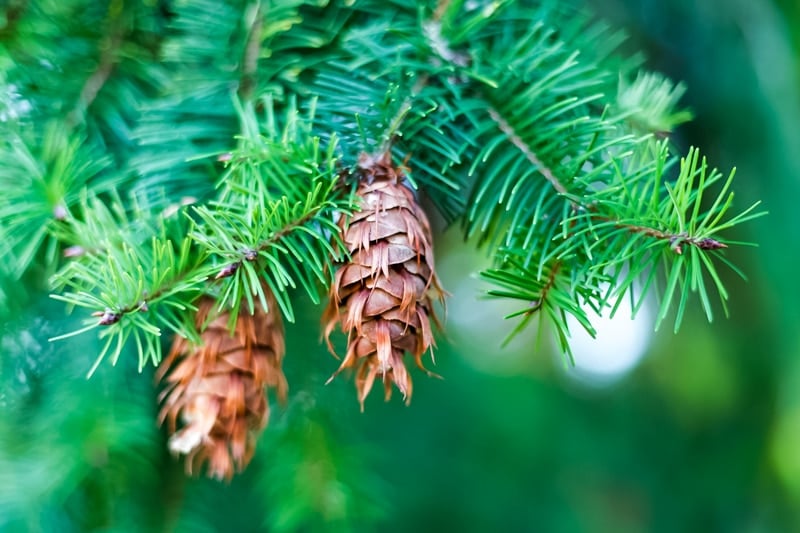
The needles of Douglas-fir trees grow all the way around the branch, and the buds at the end of the branches are brown and cone shaped. These buds are one good way to identify Douglas-fir.
The cones are brown and have a characteristic “mouse tail.”
Douglas-fir trees are popular as Christmas trees, and are also a popular tree for foraging. They have many benefits, and all parts of the tree have edible and medicinal uses, including the needles, bark, and resin.
Spruce Tree Identification
Spruce trees (Picea spp.) have four sided needles that attach to a small peg on the branch. The woody peg remains when the needle is removed.
Most species of spruce trees have stiff and pointy needles that are sharp to the touch. The needles grow around the branch.
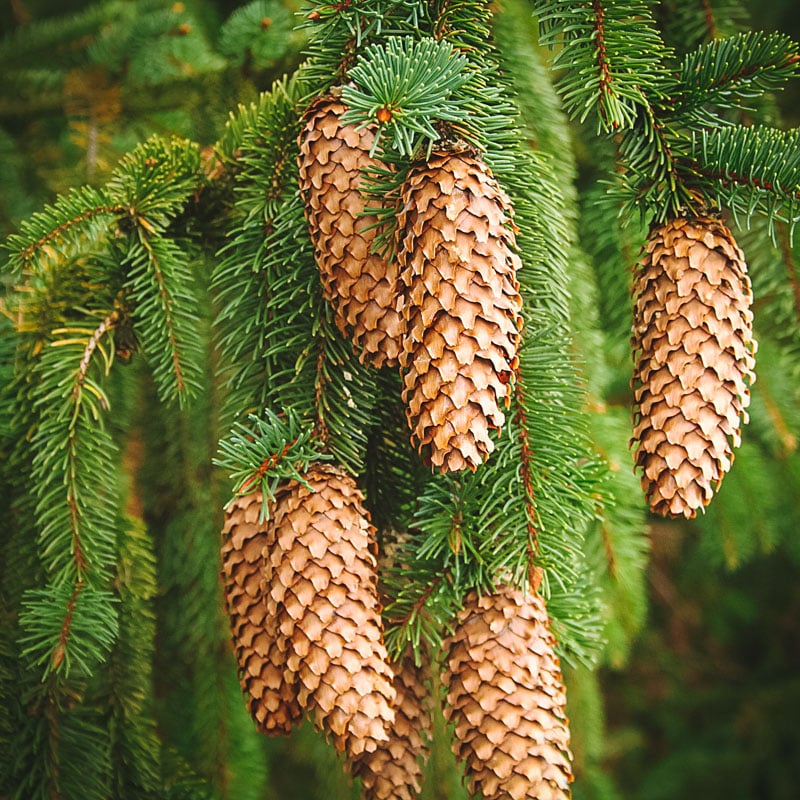
Spruce cones hang downwards, and have thin scales and a smooth, somewhat flexible shape.
New growth spruce tips form in the spring and are a popular foraged food item. They are tender and can be added to food or used to make spruce tip beer.
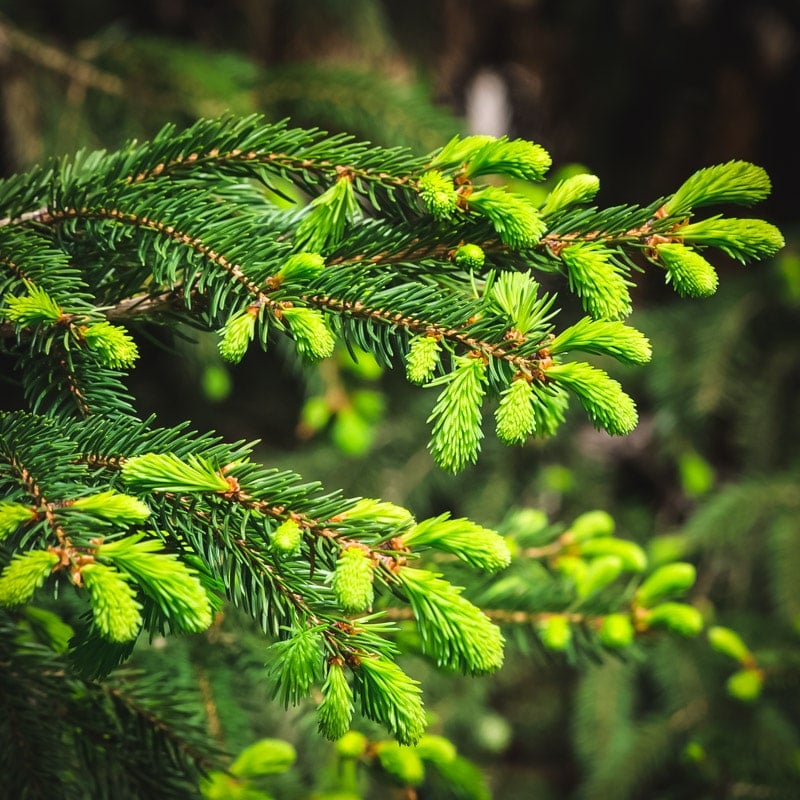
Some common species of spruce trees are:
- Blue spruce (Picea pungens)
- Norway spruce (Picea abies)
- Sitka spruce (Picea sitchensis)
- White spruce (Picea glauca)
Hemlock Tree Identification
Hemlock trees (Tsuga spp.) have short and flat needles of varying length on the same branch. This is usually the best way to identify them.
The underside of the needles of some hemlock species have two white lines.
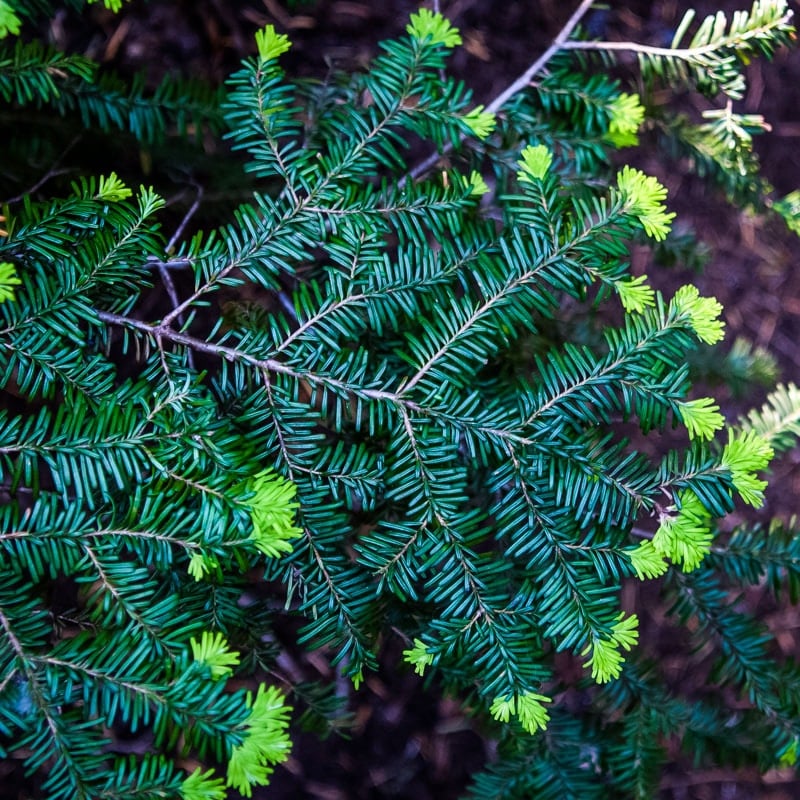
It got the name “hemlock” because it smells similar to poison hemlock when the needles are crushed, but the species are entirely unrelated.
Hemlock bark is scaly and usually deeply grooved. The cones hang downward and vary in size.
They produce light green tips in the spring, similar to spruce tips.
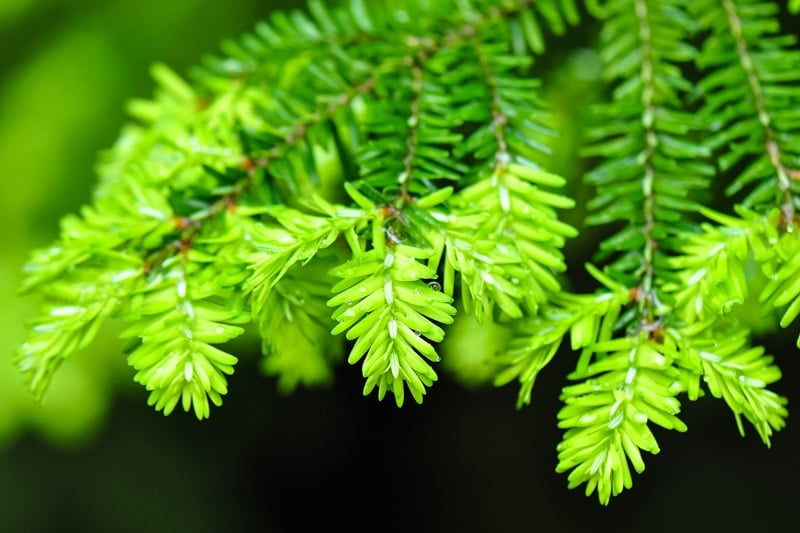
There are around ten species of hemlock, with the most common in the United States and Canada being:
- Western hemlock (Tsuga heterophylla)
- Eastern hemlock (Tsuga canadensis)
- Mountain hemlock (Tsuga mertensiana)
True Cedar Tree Identification
Cedars cause a bit of confusion because there are several conifer genera and species that use the common name “cedar,” but they aren’t all true cedars. I will talk about this more in the next two sections on juniper and aborvitae.
Here we will discuss true cedars (Cedrus spp.), which are native to the Himalayas and the Mediterranean region. They are also common in yards and parks as an ornamental landscaping plant in North America and other regions.
True cedars have needles, not scales.
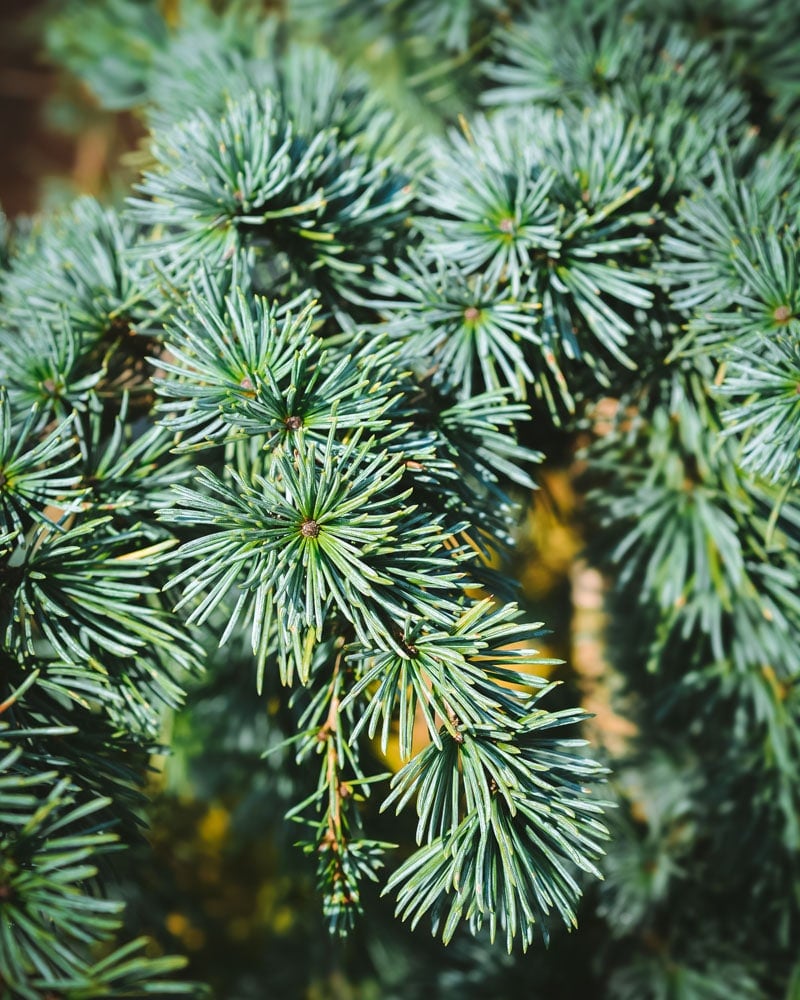
Like true fir trees, true cedar cones grow upwards.
Cedars are highly aromatic and are often used for their scent in aromatherapy and to repel bugs and moths.
There are only four main species of true cedars:
- Atlas cedar (Cedrus atlantica)
- Cyprus cedar (Cedrus brevifolia)
- Deodar cedar (Cedrus deodara)
- Lebanon cedar (Cedrus libani)
Cupressaceae Family
The Cupressaceae, or cypress family of conifers includes junipers, aborvitae (also known as thuja or cedar), and redwoods.
Juniper Tree Identification
Juniper trees (Juniperus spp.) are common throughout the northern hemisphere.
Junipers have needle or scale like leaves, depending on the species. Some have needles when young that turn to scales as they mature.
They have a distinctive aromatic “gin-like” scent and produce blue seed cones known as juniper berries.
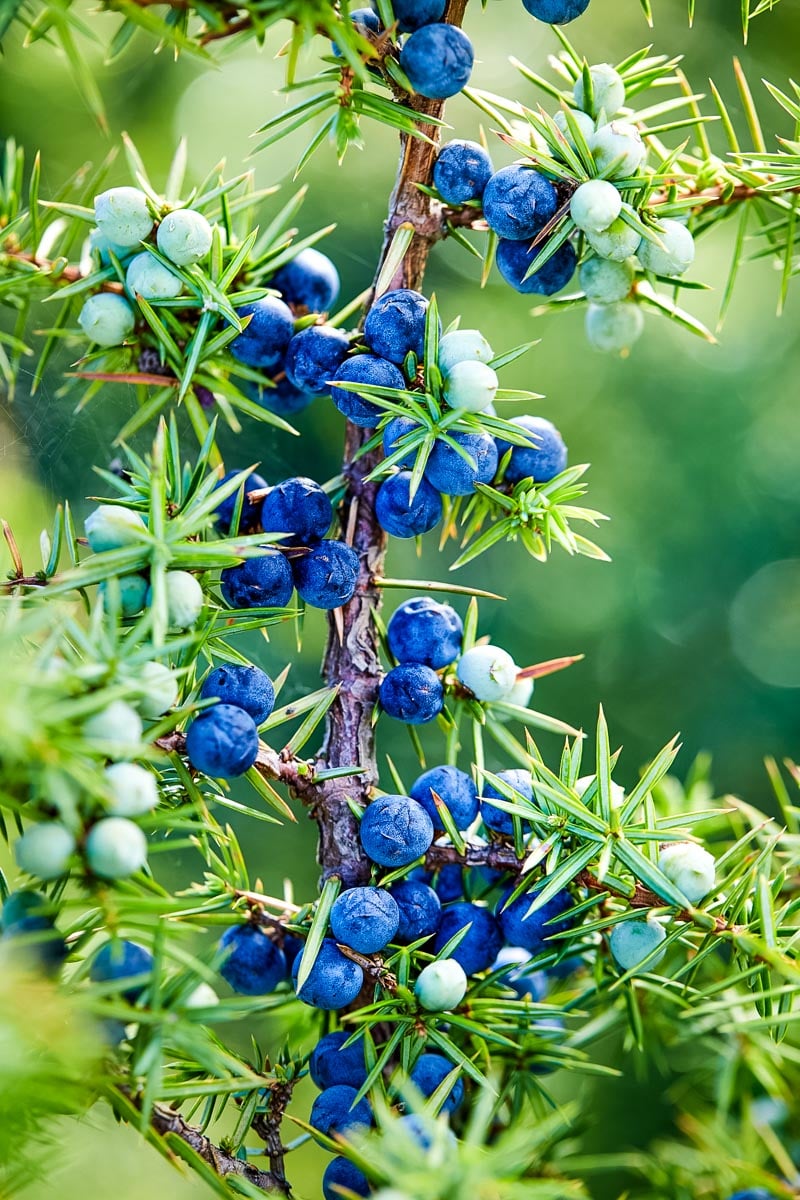
Juniper berries are generally edible and used as a spice or in making gin, but some species have mildly toxic berries.
The berries are astringent, antiseptic, antiviral, and diuretic, making them beneficial for the kidneys and urinary tract.
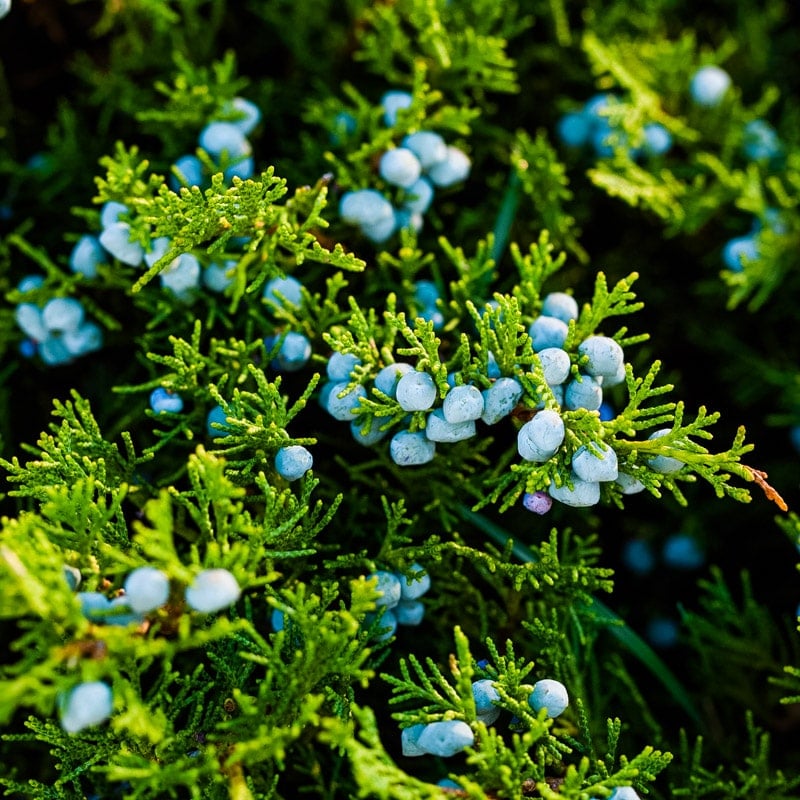
Eastern redcedar (Juniperus virginiana) is actually a juniper and not a cedar or arborvitae.
Some other common juniper species in the United States and Canada include:
- Western juniper (Juniperus occidentalis)
- Rocky mountain juniper (Juniperus scopulorum)
- Creeping juniper (Juniperus horizontalis)
Arborvitae (Thuja or Cedar) Tree Identification
Arborvitae (Thuja spp.) are also commonly known as cedar, but they are not the same a true cedars. They are native to North America and Asia.
Arborvitae have scaly leaves and reddish brown bark. The cones are small and sometimes resemble the berry like cones of junipers.
Like true cedars, they are highly aromatic and are often used for their scent in aromatherapy and to repel bugs and moths.
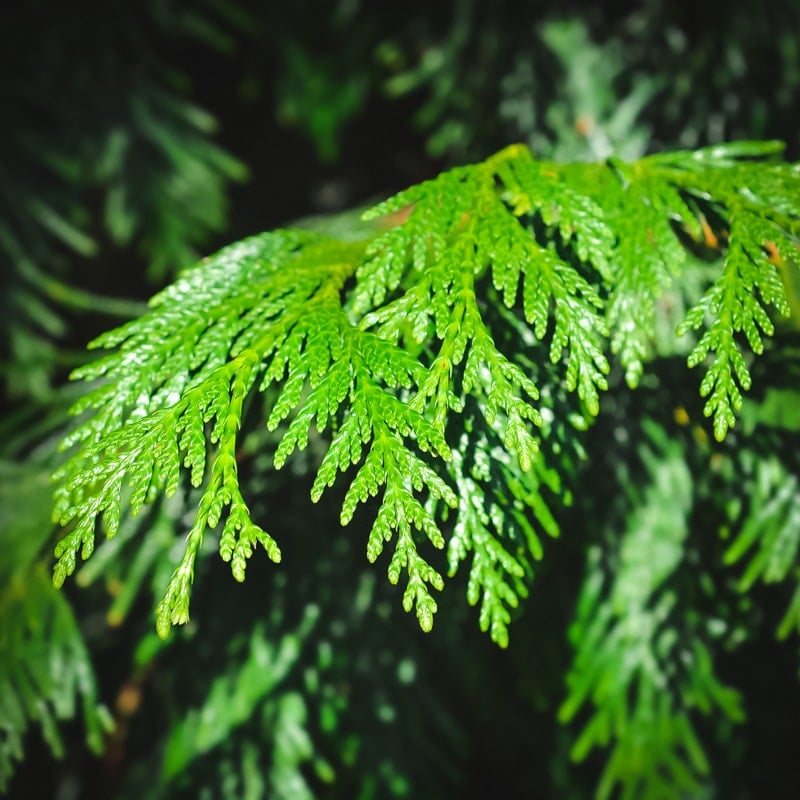
Arborvitae have a lot of medicinal benefits, being antimicrobial, antiviral, and antifungal. They are best used externally as a tincture or infused oil to be used on warts, fungus, and ringworm.
There are two native North American species: Western red cedar (Thuja plicata) and Northern white cedar (Thuja occidentalis). They have been traditionally used to make tea, but are high in thujones which can be toxic in large doses.
Arborvitae are not recommended for internal use, unless under close supervision by a health professional.
Redwood Tree Identification
Redwood trees (Sequoioideae spp.) naturally occur in northern California and Oregon, with another species that grows in China.
They have been cultivated in botanical gardens and parks around the world.
Redwoods and sequoias are very large trees with thick reddish bark and small cones.
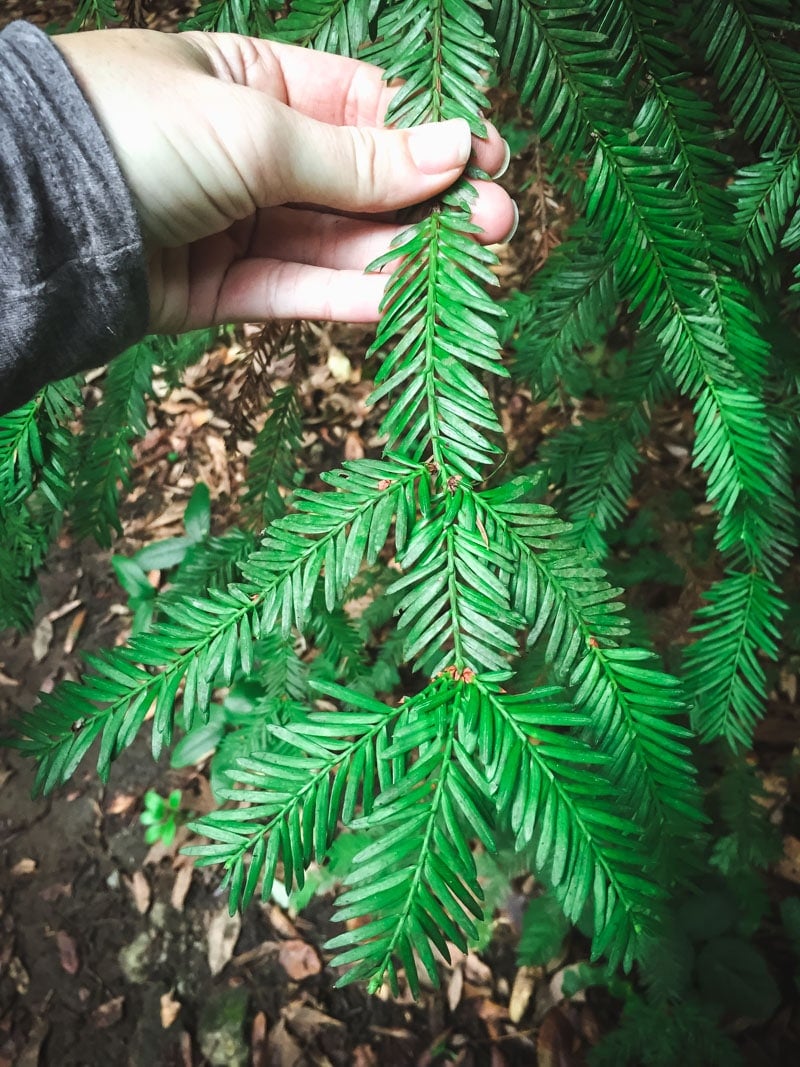
Coast redwoods (Sequoia sempervirens) grow natively on the northern Californian and southern Oregon coast. They have short and flat needles at the base of the tree, becoming more scale-like towards the top of the tree.
Giant sequoias (Sequoiadendron giganteum) grow natively in groves in the Sierra Nevada mountains of California. They have scaly, awl shaped leaves.
Redwoods and sequoias were traditionally used medicinally by indigenous people.
Taxaceae Family (Toxic)
The Taxaceae, or Yew family of conifers are highly toxic and should be avoided.
Yew Tree Identification (Toxic)
Yew trees are common and grow nearly worldwide.
Most species of Yews have red berries that have edible flesh, but the seed inside is deadly toxic.
The needles are flat, spirally arranged and have pale green or white bands on the underside.
Yew trees are generally smaller than most other conifers.
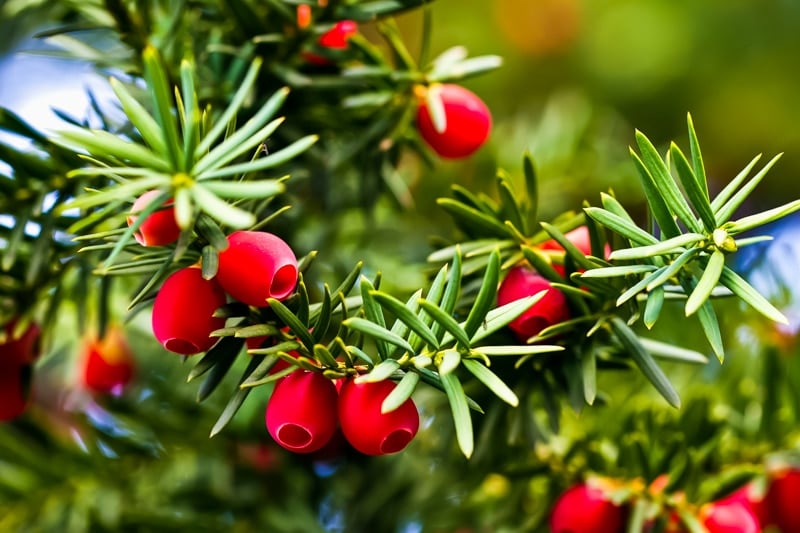
Make sure that any evergreen conifer tree that you are foraging for edible or medicinal uses is NOT in the Yew family!
Using Conifer Trees
Most conifer trees have both edible and medicinal uses. Many of them can be used interchangeably in recipes, as they have similar benefits.
Some of my favorite ways to use them include adding needles to shortbread cookies, making pine needle syrup, infusing them in alcohol, pine lotion bars, and making beard balm.
For a full list on how to use conifer needles, see my post on 30+ Conifer Needle Recipes.

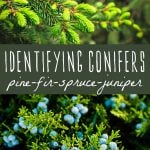
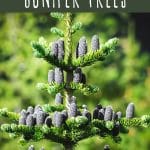
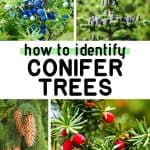
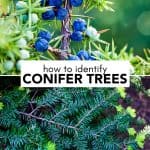
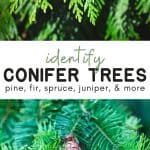
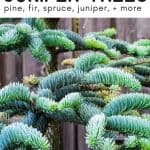
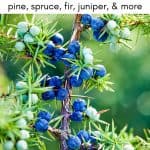
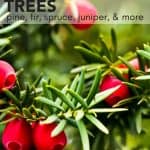
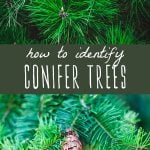

I WOULD LIKE TO KNOW IF I CAN MAKE A TEA FROM THE NEEDLES
OF MY BIRD NEST SHRUB? THANK YOU. LOVED READING ABOUT
THIS STUFF. YOUR KNOWLEDGE IS VAST.
Hi Carol. All spruce species are edible, so yes it’s edible, but edible doesn’t always mean that it tastes good. I’m unfamiliar with the taste of bird nest spruce, so I can’t say whether or not it’s flavor is pleasant.
Very informative, thank you. I think I may have an Eastern redcedar, Juniperus virginiana in my backyard, but I’m not 100% sure. I’ve tried a few plant identifier apps and they all say the same. However, I’m still scared to try the berries in case it’s misidentified. 😔
I downloaded an app called Plantnet. It was free, I have used it to identify lots of things here in Michigan, trees included! I don’t know if this can help others. Happy foraging!
I would love to have read this article, but the pop-up ads make it impossible.
I’m sorry, Judy. Ads are what continue to allow me to offer my audience free content while still making a living.
Interesting post covering a lot of species and varieties.
I think the tree at the beginning with the lovely blue/purple upright cones is Abies koreana and not as you named Abies nordmanniana unless it has two designations
Are the needles on a Mexican weeping pine tree safe to use to make tea?
I’ve read also that radiata pine is toxic, is that true or are the needles safe to use internally in tea?
I live in Reno, Nevada and nought what I thought was a giant sequoia at the coast. Although this tree grows exceptionally fast, it loses all its needles in the winter. What kind of tree do you think it is?
Hi Linda. I’m not really familiar with your area so you may want to consult a tree identification book for Nevada.
Probably a Larch also called Tamarack.
It might be the Dawn Redwood (Metasequoia glyptostroboides). Like the larch (genus Larix) the Dawn Redwood is also deciduous, along with members of the bald cypress genus (Taxodium). Dawn Redwoods are commonly grown here along the coast and do quite well. Larch on the other hand do rather poorly here and are found further north in Canada, etc., where the climate is much harsher.
Larch
Hi I live in South Africa and have a tree that an app identified as cupressus sempervirens, do you have any knowledge of that one and know if I can make a tea or not? Any advice would be very appreciated. Thank you!
Hi Patricia. I’m sorry, I’m not very familiar with the edible conifer tree species in South Africa. Sorry!
I am in Australia but I live near two trees not from here – Giant redwood and the other is an incredible Blue Atlas – just want to double check can I use the needles for tea ?
Thankyou for your site !
Maree
Hi there. I’m unfamiliar with Blue Atlas, so you’d need to do your own research on that. However, I can tell you that redwood needles are edible. Enjoy!
Can Radiata pine needles be used to make tea or is it toxic?
All pine trees are edible, so as long as you’re sure it’s a pine, it’s edible.
Hi there, is the Mediterranean Pine or Stone pine needles ok to use in a tea please?.
Hi Clarissa. Most pines are edible, but I’m unfamiliar with both of the pines you’ve mentioned as they don’t grow in my area.
Hi,
Very informative article, but I am just a beginner in foraging so I am afraid if I end up picking wrong plant, I live in Alberta province of Canada and I see lots of Conifers around I think they are Spruce tree mainly as they are as tall as buildings. I am afraid of toxic species, is there any particular way we can identify these?
Hi there. Yes, conifers can be pretty tricky to identify. I recommend getting a really good tree identification book for your area.
Thanks for this very well researched and extremely useful information.
You’re welcome, John!
My most common pine is loblolly. Would love to try a tea. Would you recommend this species for tea?
So thankful to come across your site!
Hi Julie. I don’t have that species here, but it’s edible, so you could try it in tea!
Well put together, concisely detailed information, however couldn’t find anything on Larch in here as I’d hoped… Cheers in any case
Delightful! Thank you. The photos are very defining. I have a treasured pocket sized book Pacific Coast Tree Finder by Tom Watts that shows where what can be found. But it has drawn illustrations rather than photos. Douglas fir essential oil is my all time favorite scent!
I’m so glad you enjoyed this post, Lia. Doug Fir is one of my favorite scents too!
What do you think about canning the syrup for shelf stability? Obviously the properties in the honey would be heated away but that could be added later :)
I personally wouldn’t since you’d lose the beneficial bacteria in the raw honey. Pine needle tea can be canned, but it would be easier to dry your pine needles and make the syrup when you’re ready to use it.
When you dry pine needles for later use in tea, will you loose much flavor?
Yes. Typically they’re used fresh for tea.
This is brilliant, thank you :)
You’re welcome!
Very interesting and informative site, well done!
I am trying to identify a large (50′ x 20″diameter) mature evergreen tree located in Wayne County, Indiana, probably not native. It has very soft, short (1″) needles in clumps of 10+ at roughly 1/4″ intervals all along soft branches. The cones are small, soft, and round, approx. 1″, with recurved scales, appearing similar to ranunculus blooms. The foliage is not aromatic, and does not have a lot of resin. Could this be a redwood variety???
According to the tree identifier on the Arbor Day website, it’s an Eastern White Pine (Pinus strobus).
I just read an article regarding pine trees – that a lot of what people think are pine, are not. I had no further information, and now this. Thorough, understandable, and with pictures. Easy to grasp. Thank you.
Such a great post. Thank you, Colleen! We just moved to a new home, and we have so many conifers around us. I’m excited to figure out what they are and how I can use them, and this post will help me get started. Thanks again!
I have a still and would like to make some Gin main engreadient is juniper berries can they be
found in maine.
thanks Bill
Thank you! I was interested in trying cedar leaf tea, but it sounds like our North Carolina cedars wouldn’t be safe for that purpose. Love this site. I made your dandelion salve this week, and it turned out beautifully.
Very informative & good to know. Now I just need to find a class that does wood identify to familiarize even more, just to be even sure.
Thank you so much for this. I’m taking a woody identification class right now and this has been super helpful while studying conifers. I really appreciate you putting everything together in an easy to understand way.
Amazing information. More than I can absorb in one sitting. Very well done.
Wow. Learned SO much from this! Doug Fir not a real Fir? Incense cedars not real cedars? Thank you!!!